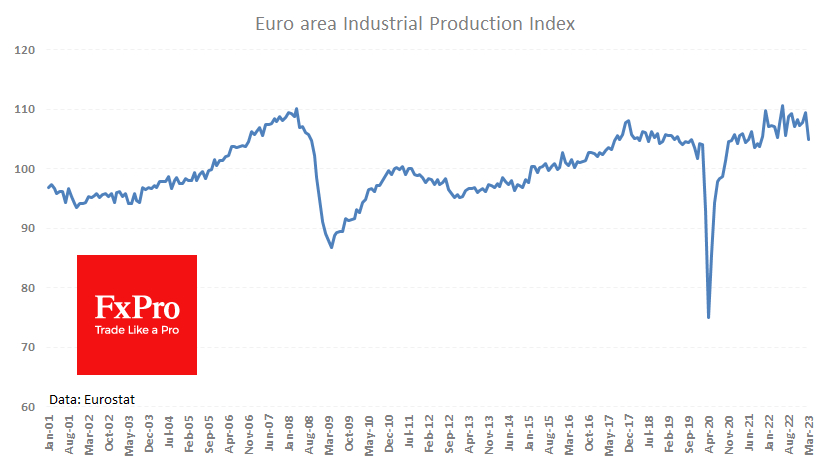Eurostat today reported that eurozone industrial production fell by 4.1% in March, the most significant drop since July last year. Compared with the same month of the previous year, output fell by 1.4%, instead of the expected +0.9%, whereas, in February, it was up +2.0%.
The seasonally adjusted industrial production index fell to its lowest level since October 2021, failing to stick to a steady growth path and reversing down from roughly the same level it has been at since 2008. The following manufacturing report promises to be quite interesting, as it will help determine whether we see a reversal to decline, as we did in 2008 and 2018, or just a tactical retreat.
In a separate publication, German wholesale prices fell by 0.4% m/m, against expectations for a rise of 0.3%. Year-on-year, the decline is 0.5%. Import prices are also in negative territory year-on-year, which should contribute to a fall in consumer inflation.
Trends in industrial production are often ahead of the economy and determine long-term trends and the performance of the euro against the major currencies. However, they rarely cause an immediate market reaction immediately after publication.
The single currency suffered short-term losses due to weak industrial production data and falling wholesale prices in Germany. This publication did not disrupt the EURUSD's overall intraday trend, with buying interest increasing as the pair touched its 50-day moving average near 1.0850.
- English (UK)
- English (India)
- English (Canada)
- English (Australia)
- English (South Africa)
- English (Philippines)
- English (Nigeria)
- Deutsch
- Español (España)
- Español (México)
- Français
- Italiano
- Nederlands
- Português (Portugal)
- Polski
- Português (Brasil)
- Русский
- Türkçe
- العربية
- Ελληνικά
- Svenska
- Suomi
- עברית
- 日本語
- 한국어
- 简体中文
- 繁體中文
- Bahasa Indonesia
- Bahasa Melayu
- ไทย
- Tiếng Việt
- हिंदी
Eurozone Industrial Production Falls to the Lowest Since October 2021
Published 05/15/2023, 07:54 AM
Eurozone Industrial Production Falls to the Lowest Since October 2021
Latest comments
Loading next article…
Install Our App
Risk Disclosure: Trading in financial instruments and/or cryptocurrencies involves high risks including the risk of losing some, or all, of your investment amount, and may not be suitable for all investors. Prices of cryptocurrencies are extremely volatile and may be affected by external factors such as financial, regulatory or political events. Trading on margin increases the financial risks.
Before deciding to trade in financial instrument or cryptocurrencies you should be fully informed of the risks and costs associated with trading the financial markets, carefully consider your investment objectives, level of experience, and risk appetite, and seek professional advice where needed.
Fusion Media would like to remind you that the data contained in this website is not necessarily real-time nor accurate. The data and prices on the website are not necessarily provided by any market or exchange, but may be provided by market makers, and so prices may not be accurate and may differ from the actual price at any given market, meaning prices are indicative and not appropriate for trading purposes. Fusion Media and any provider of the data contained in this website will not accept liability for any loss or damage as a result of your trading, or your reliance on the information contained within this website.
It is prohibited to use, store, reproduce, display, modify, transmit or distribute the data contained in this website without the explicit prior written permission of Fusion Media and/or the data provider. All intellectual property rights are reserved by the providers and/or the exchange providing the data contained in this website.
Fusion Media may be compensated by the advertisers that appear on the website, based on your interaction with the advertisements or advertisers.
Before deciding to trade in financial instrument or cryptocurrencies you should be fully informed of the risks and costs associated with trading the financial markets, carefully consider your investment objectives, level of experience, and risk appetite, and seek professional advice where needed.
Fusion Media would like to remind you that the data contained in this website is not necessarily real-time nor accurate. The data and prices on the website are not necessarily provided by any market or exchange, but may be provided by market makers, and so prices may not be accurate and may differ from the actual price at any given market, meaning prices are indicative and not appropriate for trading purposes. Fusion Media and any provider of the data contained in this website will not accept liability for any loss or damage as a result of your trading, or your reliance on the information contained within this website.
It is prohibited to use, store, reproduce, display, modify, transmit or distribute the data contained in this website without the explicit prior written permission of Fusion Media and/or the data provider. All intellectual property rights are reserved by the providers and/or the exchange providing the data contained in this website.
Fusion Media may be compensated by the advertisers that appear on the website, based on your interaction with the advertisements or advertisers.
© 2007-2025 - Fusion Media Limited. All Rights Reserved.
